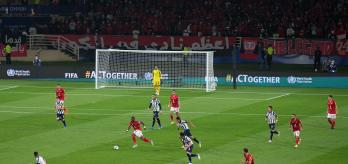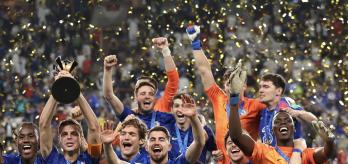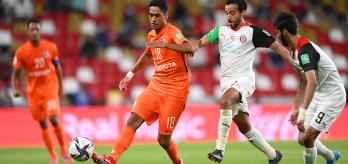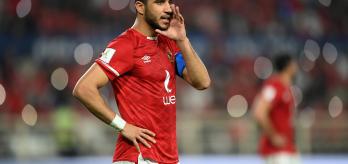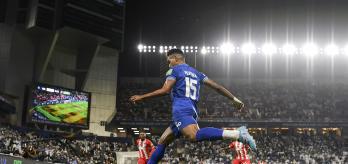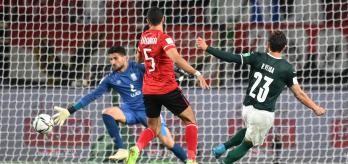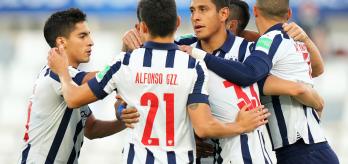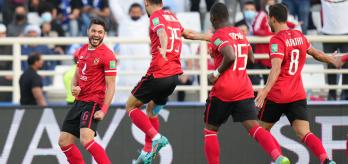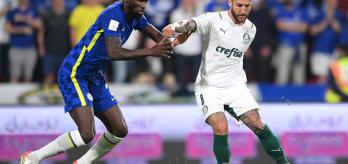A striking aspect of the game strategy was the speed of Al Ahly's counter-attacking with a game plan built on a solid team structure, aggressive yet disciplined defending and forward play that generated huge team momentum. They demonstrated strong awareness of the spaces Monterrey were conceding and were able to exploit it.
Team structure/aggressive defending
Al Ahly set up in a 3-4-3 formation, requiring their wing-backs to connect deep with the back three when they were out of possession (in a mid or low block).
Their two central midfielders were exceptionally disciplined at protecting the central channel and worked extremely hard to screen, press and tackle when the ball came into their territory.
Guarding the central channel, defensive midfielder Aliou Dieng executed 14 tackles (30% of his team's total tackles) and performed 22 defensive events, 12 above the average of all other players in the game. He was a crucial cog in the Al Ahly game plan and was instrumental in their aggressive defensive performance.
With an average defensive line height of 31m throughout the game, 22% of Al Ahly’s defensive actions were performed when they were in a low block which demonstrates their strong preference to defend in this way, particularly when we consider they only spent 2% of their out-of-possession game states in high block and 4% in mid block.
The two wide players in the front three tucked into the spaces just ahead of their central midfielders, acting as screens, initiating the press and acting as outlets on the transitions to attack. They were looking to expose the spaces vacated by the advanced Monterrey full-backs.
Al Ahly won the ball back in their low-block game state 36 times, and of those 36 ball regains, a Monterrey full-back was only in his own half on three occasions. Furthermore, both Monterrey full-backs were located in the final third 72% of the time during a turnover in possession in the same area.
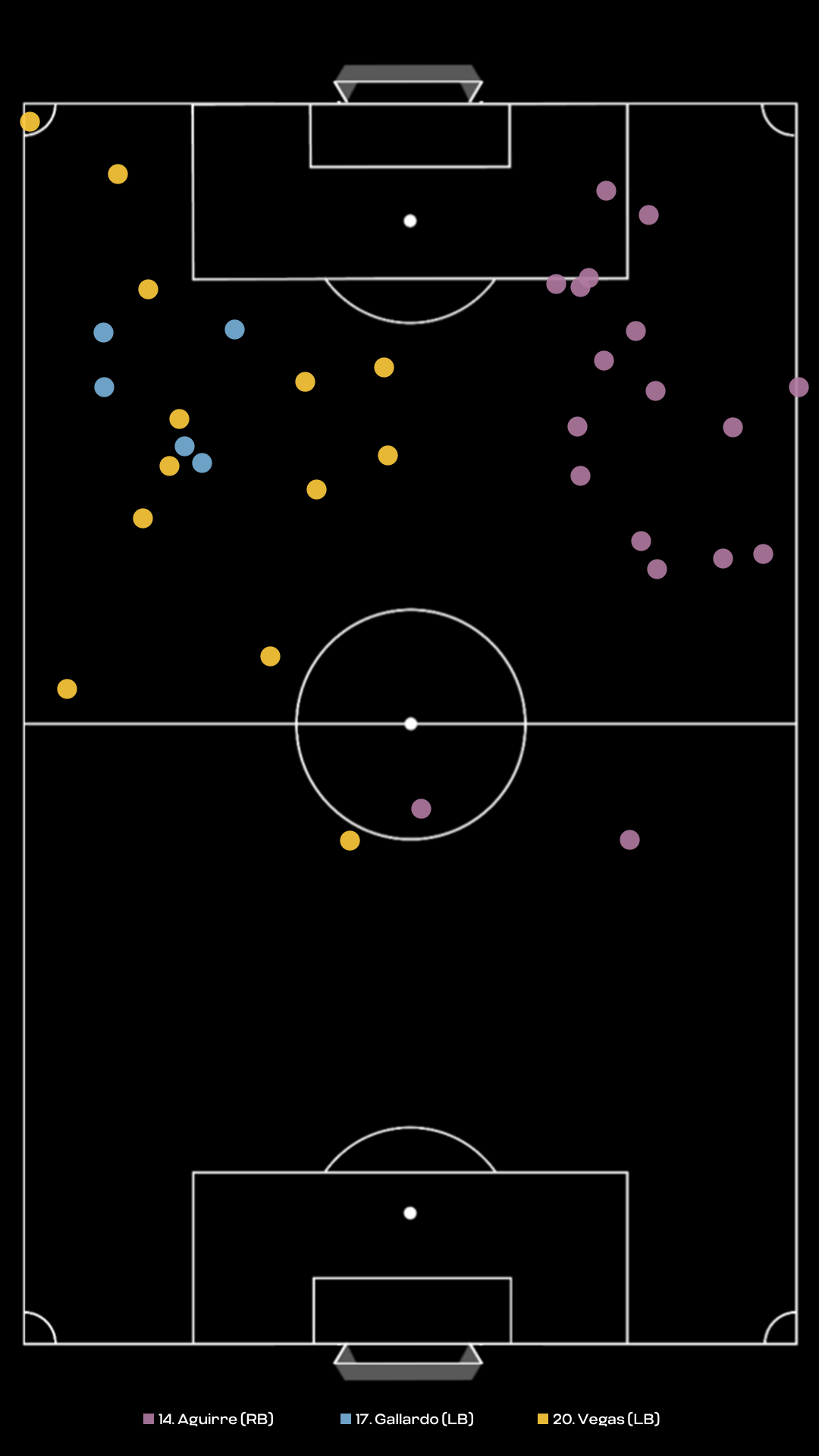
Al Ahly centre forward, (27) Taher was excellent in his positioning and movement off the ball to act as both a target player for the out ball, and as a willing runner to chase down balls in behind Monterrey's last defensive line.
Once Al Ahly initiated their press, the team went in collectively and aggressively, clearly with the intention of winning the ball back as opposed to just sending the play backwards.
Al Ahly spent 47% of their time in an out-of-possession game state in a low block, which requires greater effort to reach the opponents defensive third due to the longer distance from goal on transition to attack.
In possession, Al Ahly (4.3%) were in counter-attack game state almost ten times more than Monterrey who were only in counter-attack state 0.5% of the time.
Al Ahly were determined to protect the inside space. They were not worried about the ball going into wide areas and defending from crosses as their centre-backs were able to deal with these.
Playing forward/centre forward role
In order to maximise opportunities to transition quickly from defending to attacking, speed of play is imperative. Al Ahly were extremely impressive in their desire to play forward early meaning they were able to turn their intense defensive momentum into attacking momentum.
Their commitment to fast forward passes and forward runs combined with clever positioning, movement and decision-making from their centre forward ensured they posed a significant threat every time they counter-attacked.
Al Ahly centre forward, Taher has been highlighted as an extremely effective outlet for his team. He offered to receive the ball 55 times during the game, 12 times more than the game average. 34 of those offers to receive were in behind with Taher receiving the ball on one in four of those occasions.
Steve McClaren:
"For the game plan of Al Ahly to work, they had to be in a low block with a compact team shape and aggressive front-foot defending. But for it to work, you must have an outlet, a platform to spring from transition to counter-attack.
That means playing the ball forward as quickly as possible so the centre forward becomes a key player. In Taher, they had the perfect one. If they played a long ball in the air, he could compete and win headers. He could hold the ball up and wait for support and the key, he had clever movement and speed to run in behind.
Momentum is key to a successful counter-attack. Football is a forward thinking, forward passing, forward running game and from winning the ball, the first pass generally must be forward, followed by forward runners, who can overrun the opponent and who can also exploit the spaces left vacant.
Al Ahly did this brilliantly, often creating overloads in wide areas; or the front three, with movement and speed, were running behind the backline of Monterrey.
Decision-making and execution become the final piece of the jigsaw to complete counter-attacks, but this was a really good example of how a 3-4-3 can beat a 4-3-3 that plays with high full-backs."
End product/support structure
Once the team is committed to the counter-attack, it is crucial to have an end product. Conversion of goalscoring chances into shots on target and goals is a vital component but so too is the provision and maintenance of a secure support structure should the attacking team lose the ball.
In terms of shot efficiency, Al Ahly were more successful in terms of shots on target to shots taken ratio with 4/11 on target whilst Monterrey only got 3/19 on target.
Al Ahly's support structure also impressed our TSG. Pitso Mosimane's team demonstrated excellent game awareness and intelligence in this area, always maintaining numerical supremacy against the Monterrey forward players. When they kept two forwards high, Al Ahly held with four defenders and when their opponent left one forward high, Al Ahly maintained with three.
At times in Al Ahly's counter-attacking play, they could have been more efficient had they demonstrated better decision-making or technical execution when in the final third.
Pascal Zuberbühler also noted how the high, and brave positioning of Monterrey goalkeeper Esteban Andrada was also a factor in negating some of Al Ahly's attacking opportunities.
"Andrada's positioning was very impressive. He was so advanced and it was obvious in the game that his Monterrey defensive line had been coached to allow him to dominate his area."
However, Al Ahly's game awareness and attacking efficiency was notable in the game's decisive goal. Despite making a good goalkeeping intervention, Andrada was unable to deny Al Ahly's right wing-back, Hany from scoring, after he recognised the opportunity to advance and join his team's attack.
Roy Aitken:
"Throughout the match Al Ahly produced many moments of disciplined counter-attack play (obviously something they had worked on prior this match). The speed and endeavour from the team counter-attack was clearly evident and this was highlighted with the winning goal. Had they been more clinical with other equally impressive breaks during the match, Al Ahly could have won the game by several goals.
The final decision and execution are things I am sure the coach will be working on before the next game, although he must have been impressed with his team's implementation of the tactic."






